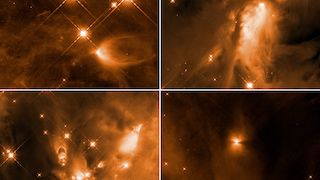Universe
ID: 30957
This visualization explores the Orion Nebula using both visible and infrared light. The sequence begins with a wide-field view of the sky showing the plane of our Milky Way Galaxy, then zooms down to the scale of the Orion Nebula. The visible light observation (from the Hubble Space Telescope) and the infrared light observation (from the Spitzer Space Telescope) are compared first in two-dimensional images, and then in three-dimensional models.
As the camera flies into the star-forming region, the sequence cross-fades back and forth between the visible and infrared views. The glowing gaseous landscape has been illuminated and carved by the high energy radiation and strong stellar winds from the massive hot stars in the central cluster. The infrared observations generally show cooler temperature gas at a deeper layer of the nebula that extends well beyond the visible image. In addition, the infrared showcases many faint stars that shine primarily at longer wavelengths. The higher resolution visible observations show finer details including the wispy bow shocks and tadpole-shaped proplyds. In this manner, the movie illustrates the contrasting features uncovered by multi-wavelength astronomy.
Flight Through the Orion Nebula in Visible and Infrared Light
As the camera flies into the star-forming region, the sequence cross-fades back and forth between the visible and infrared views. The glowing gaseous landscape has been illuminated and carved by the high energy radiation and strong stellar winds from the massive hot stars in the central cluster. The infrared observations generally show cooler temperature gas at a deeper layer of the nebula that extends well beyond the visible image. In addition, the infrared showcases many faint stars that shine primarily at longer wavelengths. The higher resolution visible observations show finer details including the wispy bow shocks and tadpole-shaped proplyds. In this manner, the movie illustrates the contrasting features uncovered by multi-wavelength astronomy.
Related
For More Information
Credits
Frank Summers (STScI): Lead Visualizer
Greg Bacon (STScI/Aura): Visualizer
Zoltan Levay (STScI/Aura): Image Processing
Lisa Frattare (STScI): Image Processing
Massimo Robberto (STScI): Scientist
Robert Hurt (IPAC): Visualizer
Joseph DePasquale (STScI): Image Processing
Leah Hustak (STScI): Video Editor
Mario Gennaro (STScI): Scientist
Martin Kornmesser (ESA): Visualizer
Greg Bacon (STScI/Aura): Visualizer
Zoltan Levay (STScI/Aura): Image Processing
Lisa Frattare (STScI): Image Processing
Massimo Robberto (STScI): Scientist
Robert Hurt (IPAC): Visualizer
Joseph DePasquale (STScI): Image Processing
Leah Hustak (STScI): Video Editor
Mario Gennaro (STScI): Scientist
Martin Kornmesser (ESA): Visualizer
Please give credit for this item to:
NASA, ESA, and F. Summers, G. Bacon, Z. Levay, J. DePasquale, L. Hustak, L. Frattare, M. Robberto, M. Gennaro (STScI), R. Hurt (Caltech/IPAC), M. Kornmesser (ESA)
Acknowledgement: A. Fujii, R. Gendler
NASA, ESA, and F. Summers, G. Bacon, Z. Levay, J. DePasquale, L. Hustak, L. Frattare, M. Robberto, M. Gennaro (STScI), R. Hurt (Caltech/IPAC), M. Kornmesser (ESA)
Acknowledgement: A. Fujii, R. Gendler
Short URL to share this page:
https://svs.gsfc.nasa.gov/30957
Missions:
Hubble
Spitzer Space Telescope
Keywords:
SVS >> Hyperwall
SVS >> Hubble Space Telescope
SVS >> Spitzer
SVS >> Nebula
NASA Science >> Universe
SVS >> Star Formation
SVS >> 4K
https://svs.gsfc.nasa.gov/30957
Missions:
Hubble
Spitzer Space Telescope
Keywords:
SVS >> Hyperwall
SVS >> Hubble Space Telescope
SVS >> Spitzer
SVS >> Nebula
NASA Science >> Universe
SVS >> Star Formation
SVS >> 4K












